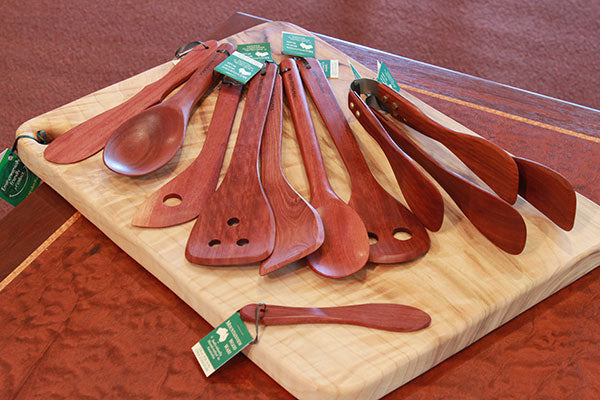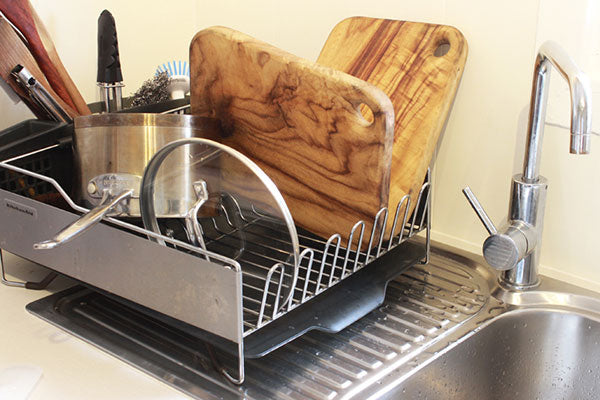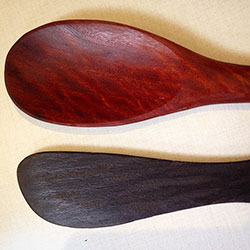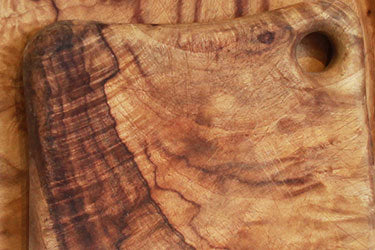How to Care for Your Wooden Boards and Utensils

(Last Updated: Dec 05, 2023) Our wooden kitchen boards, cheeseboards and kitchen utensils come with product care instructions but because of the high number of questions about this very topic, we decided that a more comprehensive article was due. It stands to reason; the various boards and kitchen utensils are beautiful and full of colour and woodgrain but how do you keep them looking like that? How do you look after them? Well, it’s not so difficult with a mixture of practical tips and a slight shift in thinking.

Washing and Hygiene, Boards
Our wooden kitchen boards, cheese boards and carving boards all just need a quick wash in warm water with a little detergent, your nylon washing-up brush is perfect, then pop them in the rack to dry before storing. The big no-no here is the dishwasher as the detergents used are very caustic and will dry out the wood plus the dishwasher will keep the boards soaking for a long time which is not advisable. In its natural state wood has bark to protect it from the elements. All wood has natural anti-bacterial properties especially Camphor Laurel (see our blog) so a quick wash as described above is all that is needed. The research conducted on the hygienic safety of wooden boards is compelling and let’s face it, Jamie Oliver wouldn't use anything else. An often-asked question is ‘Do I need separate boards for meat and other foods?” and we advise that you follow your own feelings on this as there are many schools of thought and it is the official guideline for the hospitality industry. For us, however, we just have a number of boards on hand and if we have cut up meat on one, we wash it and grab a fresh one for veg preparation, simple. Every now and then rub a lemon over the boards and put them out in the sun for half an hour for a thorough sanitisation.

Washing and Hygiene, Utensils
Our range of Red Hardwood kitchen utensils need the same regimen as the boards when it comes to washing – a quick wash with a brush and a little detergent, pop in the rack to dry, bingo. You will not need to do the lemon and sunshine protocol but do keep them out of the dishwasher as they are slender and have a large surface area so they will dry out quickly.
Beauty Maintenance
You all know the mantra of skin care ‘cleanse and moisturise.’ Well, your boards and utensils are not very different, they need cleansing (see above) and moisturising or actually, oiling, which is the same thing for wood. Your boards and utensils won’t need to be oiled on a daily basis, however, just as needed which you can tell by looking. Does the surface look a little dry? Have you been catering for the multitudes and giving your boards and utensils a hard workout? Time to feed them with a little oil and any fine edible oil is OK to use. The one oil that is not advised is thick virgin olive oil, which is not highly refined (that’s what makes it delicious) and whose contents can attract mould in a hot, humid climate.

On the left, the kitchen workhorses; on the right, kept for best.
Use Your Wooden Things or Keep for Best?
Often heard is the exclamation that the boards are too beautiful to use or “I would be afraid to use them” and this is where a shift in thinking may be necessary. These boards and utensils are meant to be used, daily, all the time. They are meant to bring you years of happy use and so what if your boards get a few scratches and knife marks? It will not affect the board’s usefulness or longevity and wood ages gracefully, unlike plastic. Wood can take being a bit battered and weathered and still look beautiful. If you are really bothered then every 5 years or so, get out the sander and take half a millimetre off the surface of your board, give it an oil and it will be like new. And if your favourite stirrer goes dark with age and use? It doesn’t matter, it still works well, just look at the photo. The spoon is about 18 months old and still looking great while the shaped stirrer, an old campaigner, is around 12 years old and even though now very dark, the edge is still perfect. Our special-purpose cheeseboards are in a slightly different category in that they are intended only as serving boards and are not for the rough and tumble of daily kitchen life. But it is entirely feasible to keep some rough-and-tumble kitchen utensils and boards for best. The utensils are such a beautiful colour and the Camphor Laurel boards are so pretty that you may want to keep them as serving items for dinners, brunches and picnics. Eventually, they may be relegated to everyday use in the kitchen, losing their 'for best' status – all good. So, looking after your wooden boards and kitchen utensils is not really so hard and an old and worn piece of wood will still have natural warmth and beauty whereas an old and worn piece of plastic most definitely will not.


Newish spoon, v old stirrer What do a few scratches matter?







Is there a varnish that could waterproof them ?